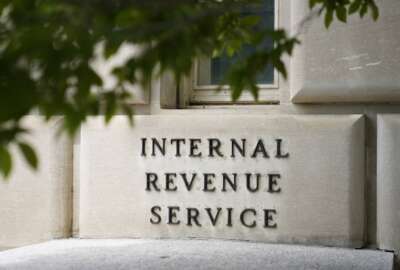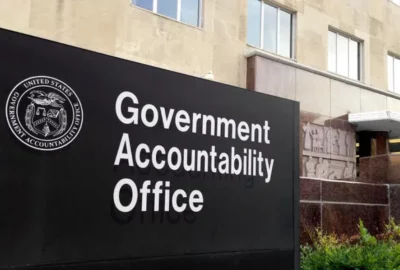Hubbard Radio Washington DC, LLC. All rights reserved. This website is not intended for users located within the European Economic Area.
DeJoy says USPS will fix ‘deteriorating’ service in regions facing network shakeup
Postmaster General Louis DeJoy said USPS is seeing “significant issues” with on-time delivery in regions where USPS is opening massive new facilities.
The Postal Service is seeing problems with on-time delivery of mail and packages in areas where the agency is implementing its network modernization plans.
Postmaster General Louis DeJoy said Tuesday that USPS is seeing issues with on-time delivery in regions where USPS is opening massive new facilities meant to streamline local operations.
DeJoy told members of the Senate Homeland Security and Governmental Affairs Committee that he’s still “optimistic about the changes,” and expects service to stabilize in impacted regions by this summer.
“The road to success will not be a straight, easy path. Rather, it will be a series of accomplishments, struggles and recoveries that will be uncomfortable at times,” DeJoy told the committee.
Network modernization plans, he added, remain a central part of USPS plans to cut $5 billion of costs and inefficient processes over the next two years — and vital to keep the agency from running out of cash and meet its long-term financial goals.
“In regards to service deteriorating, we recognize that, and we apologize to the constituents that have received that service. But in the long term, if we don’t make these changes, that will be every day, everywhere around the nation,” DeJoy told the committee.
USPS recently opened Regional Processing & Distribution Centers (RPDCs) in Atlanta and Richmond, Virginia. These large facilities serve as hubs for long-distance transportation, where employees sort mail and packages going to other regions, as well as sort incoming packages for delivery in the region.
But agency watchdogs warn that on-time delivery in both Atlanta and Richmond has dropped off significantly since USPS opened these new facilities.
Postal Regulatory Commission Chairman Michael Kubayanda said that in March, only 16% of letters and cards were delivered on time in Atlanta. About 36% of inbound first-class mail is now being delivered on time in the metro area.
While Kubayanda said he hopes service performance in Atlanta is an “outlier” and will rebound, he added that “national service has also been subpar and trending in the wrong direction.”
“While some disruption should be expected with these network changes, the bottleneck in Georgia does suggest some underlying problems,” Kubayanda said.
While USPS says these network changes are needed to improve operations, Kubayanda said the agency hasn’t actually cut costs, despite overall lower mail volume, and that efficiency “fell by a historic amount” last year.
The Postal Regulatory Commission issued an advisory opinion in 2021 when USPS lowered its standard for on-time mail delivery. But Kubayanda said a new advisory opinion “makes sense as the Postal Service ramps up the national rollout of new processing plants and transportation options.”
“These changes are clearly having an impact on service,” Kubayanda said.
USPS Inspector General Tammy Whitcomb Hull told lawmakers that after USPS launched its Regional Processing and Distribution Center in Richmond last July, the facility saw a 700% increase in extra trips between facilities to deliver mail and packages.
Hull said on-time service performance for first-class mail in Richmond fell to 65% — a more than 20% reduction compared to prior service.
“Unfortunately, we cannot isolate how much of the service decline resulting from this initiative compared to other events, such as peak season,” Hull told lawmakers.
DeJoy wrote in his testimony to lawmakers that these regional delays stem from severe employee attendance issues, gaps in transportation scheduling and an “overall inability to rapidly progress from the costly and deteriorated operating practices embedded in our legacy working environment to the high level of precision now required in our performance.”
“Those two plants — Richmond, Atlanta and the whole Georgia area — will be the finest running parts of the organization very shortly. We have to allow time to transition,” DeJoy said.
The inspector general’s office is reviewing USPS readiness for the November election, and expects to release a report in late summer.
DeJoy told lawmakers that network modernization plans won’t impact the delivery of mail-in ballots and that he will “slow down a lot of the moves” that are still in the works prior to Election Day.
“I’ve taken my foot on and off the pedal, as appropriate, to capitalize on momentum,” he said.
USPS goes through “extraordinary measures” each year to ensure on-time delivery of ballots and election mail. Those extraordinary measures include extra deliveries and collections, arranging special pickups, expanded hours at processing facilities and bypassing some standard mail processing procedures to fast-track ballots to election officials.
USPS Board of Governors Chairman Roman Martinez IV said these changes are “critically necessary,” and that the agency’s 10-year Delivering for America reform plan “is the only viable path for the Postal Service to become financially self-sufficient over the long term.”
“We fully recognize that these changes will not be without impact and temporary service disruptions. We also firmly believe that we must absorb such impacts and recover from them as quickly as possible,” Martinez said. “There will be times when the service falls short of our standard, and the Postal Service will move quickly to address them.”
USPS ended fiscal 2023 with a $6.5 billion net loss, and expects to see a similar loss this year — falling short of its “break-even” goals. However, DeJoy said USPS was “destined for financial collapse” prior to his tenure, and that the agency is no longer on the path of seeing a $160 billion net loss over the next 10 years, as previously projected.
“The Postal Service had been in a financial death spiral for the 14 years prior to my arrival in June of 2020 and had no plan to curtail these losses, and therefore no plan to become fiscally self-sufficient,” DeJoy said. “We remain firm in our position that the status quo is not an option if we want a financially self-sufficient Postal Service that provides the high-quality service expected of us,” DeJoy said.
Art Sackler, executive director of the Coalition for a 21st-Century Postal Service, told Federal News Network that higher mail prices, lower rates of on-time delivery and the agency’s overall financials show that USPS needs to “get back on track.”
“If the Postal Service were publicly traded, its board would be pushed by shareholders to reassess,” Sacker said.
USPS is planning to raise the price of a first-class Forever stamp from 68 to 73 cents on July 14, pending approval from the Postal Regulatory Commission. It would be the sixth increase of its kind since 2020, when USPS got approval from its regulator to set mail prices higher than the rate of inflation. A recent study warned USPS price increases are driving away more customers than the agency anticipated. USPS said the data behind the study was “deeply flawed.”
“What’s happening now is that, regardless of how much of their business they’re pushing away, they’re determined to just keep going ahead,” Sackler said.
Congress sought to ease the Postal Service’s financial burdens when it passed the Postal Service Reform Act in April 2022.
The legislation will save USPS $50 billion over the next 10 years by eliminating a provision from the 2006 Postal Accountability and Enhancement Act that required USPS to pre-fund retiree health benefits well into the future. The legislation also forgave USPS’ obligation to pay $57 billion in scheduled payments to its retiree health benefits fund.
DeJoy told lawmakers that the pre-funding requirement, combined with an inability to raise mail prices beyond the rate of inflation before 2020, was a “dagger in the heart of the Postal Service.”
The Washington Post reported Monday that USPS is asking the Office of Personnel Management to give back more than $14 billion in what the agency considers decades of overpayments into the Civil Service Retirement System (CSRS).
Martinez said USPS remains “saddled with paying a disproportionate share of CSRS costs” for employees who worked for the agency before 1971, when it was called the Post Office Department, and was part of the president’s Cabinet.
Martinez noted that USPS is expected to cover the full cost of CSRS benefits while other federal agencies are not.
Sackler said the mailing industry, postal unions and USPS have called on the Biden administration to give USPS back its overpayments, in a “bid to stabilize it financially and take pressure off these pernicious rates.”
“We’ve all asked the White House to consider this seriously,” he said.
Sackler said the $14.4 billion USPS is asking for is just a “small fraction” of what overall USPS overpayments into the CSRS fund, according to some estimations. USPS OIG reports CSRS overpayments could be as high as $111 billion.
“I would hope that if they get the $14.4 billion, they’d look at that as a downpayment,” he said.
However, the Justice Department Office of Legal Counsel, in a March 26 memo, said USPS is responsible for the full cost of retirement benefits owed to its employees under the Civil Service Retirement System, including increases in benefits during employees’ years of service working under the Post Office Department.
Committee Chairman Gary Peters (D-Mich.) said that so far, USPS changes “appear to be moving in the wrong direction” with its network modernization plans, and there is no clear evidence that these changes will improve service in the long term.
However, Peters told DeJoy that he’s open to revisiting legislative topics of USPS reform, such as allowing the agency to invest its pension fund in more than just low-risk, low-reward Treasury bonds.
“We stand ready to help, but we just need more transparency. We need to know what’s happening. We want some caution, and not just believing that a plan works, but also being able to back that up with data that shows that it’s actually happening,” Peters said.
Ranking Member Rand Paul (R-Ky.), however, rejected plans for USPS to recoup CSRS overpayments, saying “no funding should be given to USPS without changing its labor practices.”
“USPS needs massive structural reform — not necessarily in its network, but in its workforce, hiring and retention,” Paul said.
Since January 2021, USPS has converted more than 150,000 employees from pre-career to career positions, with higher pay and full benefits. Paul said shifting more employees to full-time career status is only making the agency’s financial problems worse.
“At some point, Congress needs to pull its head out of the sand and stop giving money we don’t have to an agency to maintain the status quo, especially when the status quo means more deficits,” Paul said.
DeJoy said converting those employees to full-time status was the “right thing to do,” since career employees have a lower rate of turnover than pre-career hires, and that the agency suffered from major staffing problems at the height of the COVID-19 pandemic.
He said the agency plans to keep hiring under its “growth plan” to expand its package business, but USPS has about 20,000 fewer employees than when he took office, and that the organization eliminated 50 million work hours last year.
“We will right-size our workforce for the work that we have to do,” DeJoy said.
Copyright © 2024 Federal News Network. All rights reserved. This website is not intended for users located within the European Economic Area.
Jory Heckman
Jory Heckman is a reporter at Federal News Network covering U.S. Postal Service, IRS, big data and technology issues.
Follow @jheckmanWFED
Related Stories
Federal security agency struggling with new IT system for tracking contract guards
Related Stories
-
GAO reviews how the VA is training its claim processors Agency Oversight





